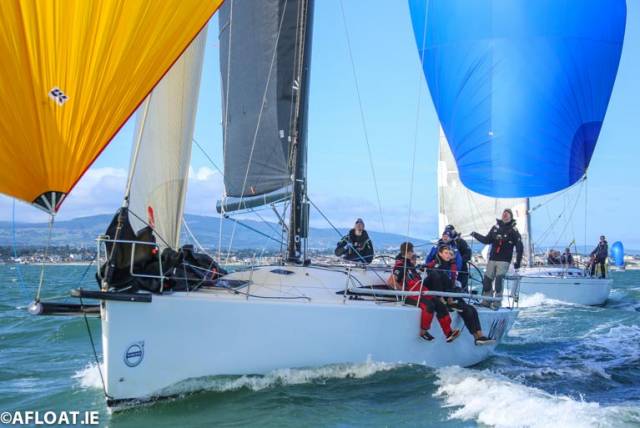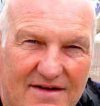Four-time Olympic Helmsman, Sailing Coach and Agent/Consultant for UK Sailmakers Ireland, Mark Mansfield explains how the Helm and Trimmers on larger keelboats and cruisers should be in continual communication to go fast on the race course
Following on from the successful series on Top tips articles dealing with upwind and downwind sailing over the last few months, I am now going to go through how a Helmsman or woman and their trimmers should work together for the best results.
Most helms will likely have at some point raced smaller keelboats or dinghies, where the helm not only steers, but also controls the Mainsheet or the Traveller, or both. This allows the feel and weight on the tiller to be handled by the helm and allows the helm to react quickly and proportionately by adjusting the traveller, mainsheet, or even backstay. On bigger boats, the loads are more substantial, and often a specific mainsheet person controls all of these.
Downwind how deep you steer is also quite tricky to work out and again there is someone else, usually the Spinnaker trimmer very much involved. So for this article, I will break down my thoughts into
- Upwind—Helm working with the mainsheet trimmer
- Downwind—Helm working with the spinnaker trimmer
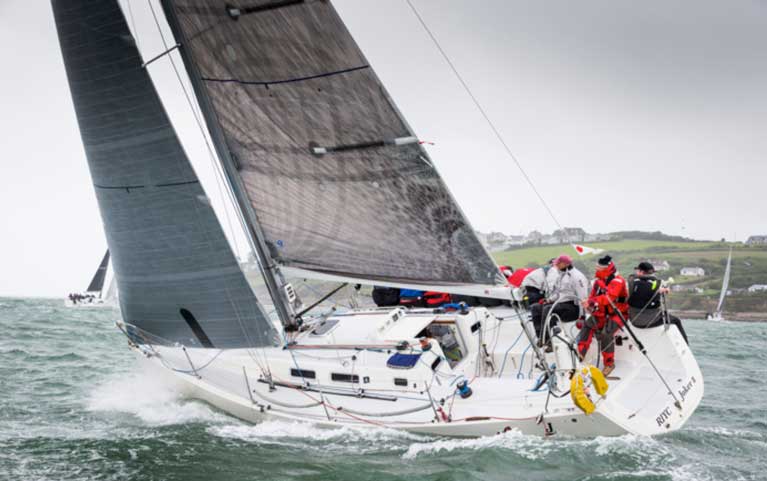 Author Mark Mansfield is working with John Maybury on J109 Joker II on her way to winning her third straight ICRA Nationals in 2017. Joker 2 will be going for four in a row in 2019 as there were no ICRA nationals in 2018 Photo: Bob Bateman
Author Mark Mansfield is working with John Maybury on J109 Joker II on her way to winning her third straight ICRA Nationals in 2017. Joker 2 will be going for four in a row in 2019 as there were no ICRA nationals in 2018 Photo: Bob Bateman
Upwind—Helm working with the Main Trimmer
The Helm has a substantial advantage in knowing how to trim the sails, as he can feel the amount of weather helm (or lack thereof) in the tiller (or wheel). Often though, this advantage gets lost as:
- He does not communicate that feel to the mainsheet trimmer
- When he does, he does not communicate it properly
The Mainsheet Trimmer, in a perfect environment, should be responsible for the set up of the sails upwind (both Headsail and Main) and should be working also on how the Rigging should be adjusted. The Headsail trimmer is essential when setting up the Headsail before the race and should link in with the Main trimmer on this to get a right combination of trimming going. However, once the race starts, usually the Headsail trimmer is needed on the rail, leaving only the Main Trimmer and Helm sitting in. Therefore, the main trimmer also has to look at adjusting the Headsail as well, if needed. An example of this is in tacking. The jib trimmer winds in the headsail to what he/she thinks looks good. However, the boat is just building speed, so apparent wind is not entirely built when he/she hits the weather rail. Also his/her weight when it gets to the weather side, puts further power into the sails, opening the leech. This added to extra apparent windspeed, once the boat gets up to full speed, opens the jib leech even further. It is then the Mainsheet trimmers job to go down and check the jib, and often another wind on the winch is required.
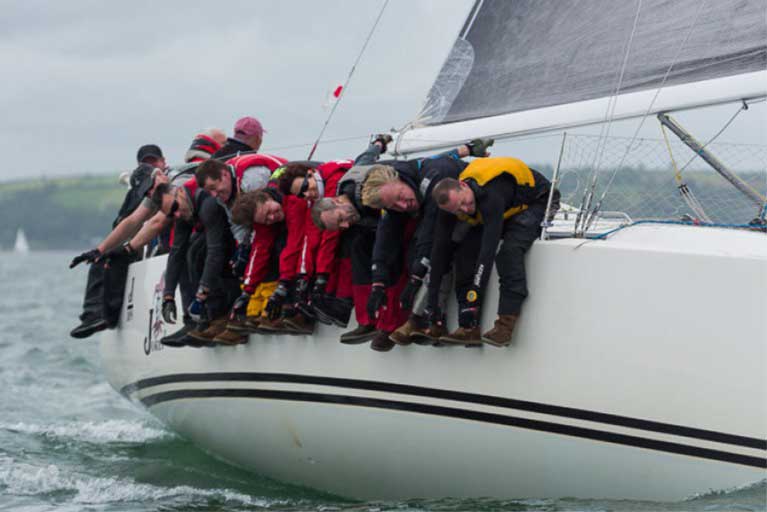 Joker 2 going upwind. Helm and Mainsheet trimmer getting the cushy jobs. Photo: Bob Bateman
Joker 2 going upwind. Helm and Mainsheet trimmer getting the cushy jobs. Photo: Bob Bateman
Communication Between Helm & Main Trimmer: Upwind
A Non-communicative Helm is a big problem, as the mainsheet trimmer does not have the advantage of what the helm is feeling. On most boats when I am steering, the helm balance will likely tell me if I need more Power or less power. Typically, if my helm has more than 4 or 5 degrees of weather helm(see my tip on Figuring how much this is)(link to my top 10 tips upwind where I cover this), then my rudder is acting like a brake instead of a lifting foil. Then I will ask my Mainsheet person to either:
- ease mainsheet
- drop the traveller
- Add more backstay
So, which one? Normally, I go:
- Traveller down first, to a max of about a foot below centreline—any more and there is too much backwinding
- Backstay on further—to a max of when the Main is overbending and wrinkles from the middle of the mast to the end of the boom occur. Remember more backstay will open the main leech, so further mainsheet may then need to be pulled in. What you are trying to do is flatten the whole sail, but keep the leech still tight to aid pointing.
- Only when these two options are not enough, would I look at easing the mainsheet.
If the helm tells you he/she has no feel in the helm, then the Mainsheet persons job it to try and add power, generally to the Main, to get more bite in the helm. The opposite of the above is then the way,
- Traveller up—to a max of the boom being slightly above the centerline.
- Ease the backstay. This will power up the main, by straightening the mast. Always however keep a minimal amount of backstay on, to stop the Forestay pumping, as backstay tension has a significant effect on your forestay sag. Easing the backstay will tighten the main leech so will likely require an ease also on the mainsheet.
- Tighten the Mainsheet if above 2 items are still not giving the helm enough feel.
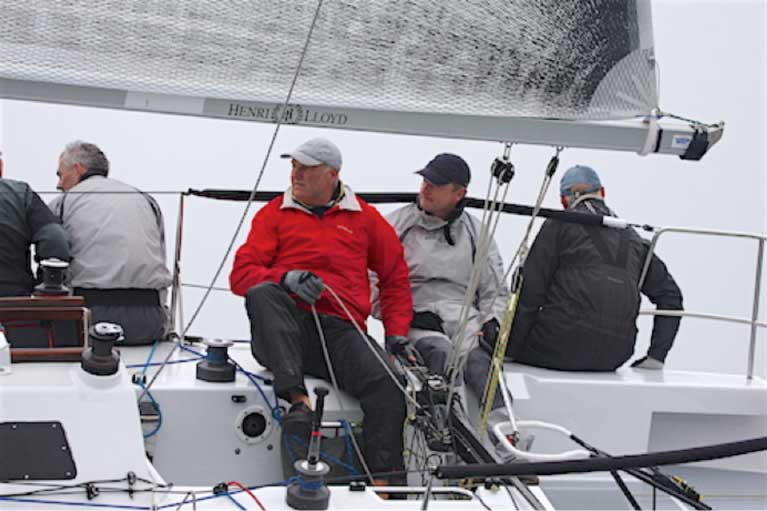 Mark Mansfield is communicating with Mike Evans (helm) on Big Picture at the 2016 Half Ton Cup in Falmouth
Mark Mansfield is communicating with Mike Evans (helm) on Big Picture at the 2016 Half Ton Cup in Falmouth
If the helm cannot work out which of these 3 to do, then the least he/she should say is—"I need more Power", or he/she should say –"I need less power". Then it is up to the Mainsheet person to try one of the 3 changes above. What he/she(helm) must not do is say nothing, and hope the mainsheet person picks up what is wrong. When I am on the main, I am always looking to see how much weather helm, or lack thereof, is evident and if I see too much or too little, I will ask the question of the helm. Watching the speed and wind angle on the clocks is also essential. If everything is good, the boat is fast and high, then the Mainsheet person should say that, as it is an excellent positive statement. If speed and height are not great, then the Mainsheet person should suggest a positive change, like, "let's try a bit more Backstay", or Maybe we might try footing a bit".
If the Mainsheet person, looking at the telltales, is seeing the helm is off the wind, he should immediately say it, as losing height, without much extra speed, is a real negative. On many boats, where I sail as mainsheet, I will regularly point out if I feel we are not sailing at the right angle. High concentration levels from the helmsperson are required all the time to ensure the boat is ideally on the wind and often that concentration can lapse a bit. It is the mainsheet person's job to watch for this and keep the helm concentrating.
Often during a long day, where up to 3 races might be sailed, it is worth looking at the helm handing over for some legs(maybe downwind legs later in the day), to keep concentration levels going on the upwinds. The best Helm/Mainsheet combinations are those that are continually talking together about speed, height and feel.
Communication Downwind
Unlike upwind, downwind is all about communication between the Helm and the Spinnaker trimmer. The Mainsheet person is usually a bit redundant as often, especially on dead downwind legs, the main goes out entirely and is not trimmed much. Downwind, the phrase: 'the Spinnaker Trimmer should be steering the boat downwind', is correct. He/she doesn't hold the helm, but they direct where the boat goes.
 John Maybury's Joker 2 running downwind on the way to an overall win in Dun Laoghaire Week Regatta in 2017
John Maybury's Joker 2 running downwind on the way to an overall win in Dun Laoghaire Week Regatta in 2017
The Helm has some feel downwind, but nothing like what is being transmitted back to the spinnaker trimmer from the power coming through the spinnaker sheet. The Spinnaker trimmer must now be the communicative person. A quiet spinnaker trimmer is a slow spinnaker trimmer. He must boss the boat down the runs. He must be continually talking to the helm about depth and speed and calling the helm up and down. So, "up 5" or "down 5" are the sort of things you would expect to be hearing from the spinnaker trimmer every 10 or 20 seconds., meaning up 5 degrees or down 5 degrees. He/she will be doing this as pressure builds and drops on the spinnaker sheet. More pressure allows the boat to go deeper, less pressure, height needs to be the call to keep the speed on. As a general rule, the spinnaker should be steady, and the spinnaker sheet should have decent pressure. If it does not, then the spinnaker is not pulling the boat forward. The spinnaker trimmers job is also to call the trim on the guy(or on Asymmetric) and also the pole height. As a general rule, the pole should be at right angles to the wind, and in that scenario, the spinnaker luff should stand straight up, parallel to the mast, and curl in the middle. If the spinnaker is rolling to weather of the pole, the pole needs to come back. If the spinnaker is falling to leeward of the pole, the pole needs to go forward.
Often I find Spinnaker trimmers just pulling in and out the spinnaker sheet, without communicating where the helm should point the boat, or without trimming the pole backwards and upwards. It is the Spinnaker trimmers job to do all these things.
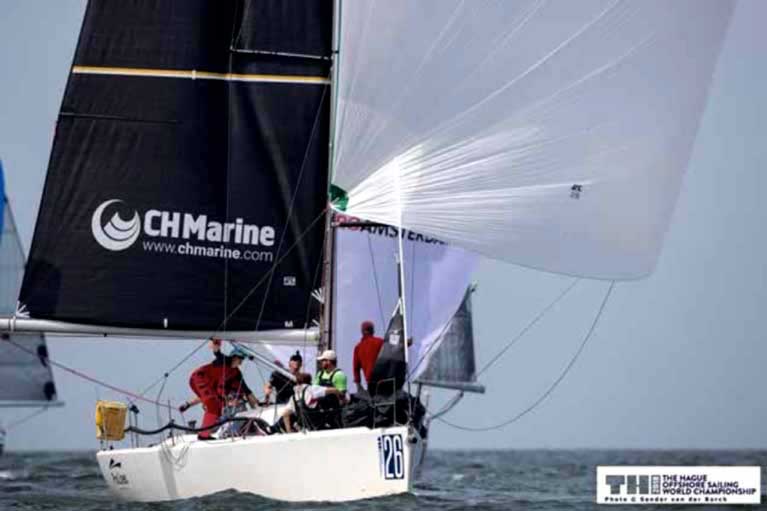 Fools Gold, during the IRC Worlds in Aug, VMG running with Mainsail and A2 Spinnaker, both from UK Sailmakers Ireland. Note many of the crew are forward of the mast
Fools Gold, during the IRC Worlds in Aug, VMG running with Mainsail and A2 Spinnaker, both from UK Sailmakers Ireland. Note many of the crew are forward of the mast
Conclusion
The feel upwind (on the wheel or tiller) or downwind (on the Spinnaker sheet )are extremely important and cannot be kept to oneself. Increase the communication levels, and in nearly all cases, the boat will go faster.
So, apart from the helm, if you have one particularly good sailor on the boat, by rights, for best speed, that person should trim the main upwind and the spinnaker sheet downwind. This is not always popular on boats wanting specific positions for the various crew. Also, often the mainsheet person might also be doing/helping with the tactics. When going downwind, calling where to go and where the pressure is, can be very important as well. All decisions to be made on a boat to boat basis.
Fair Sailing


























